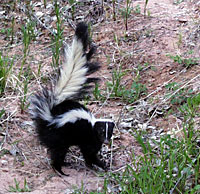|
Skunk
Most people have smelled a skunk, but haven't seen one. Skunk watching is fun, but keep your distance! When threatened, they spray a foul-smelling musk from their rear end. |
|||||||||
|
The
Striped Skunk (right), Eastern Spotted Skunk, Western Spotted Skunk,
Hognose Skunk, and Hooded Skunk are all found in North America. Skunks
are sometimes called civet cats and polecats.
All skunks are boldly colored. This is an an advertisement to their enemies that they should not be bothered. They use their bad smell to mark their territory and to repel danger. |
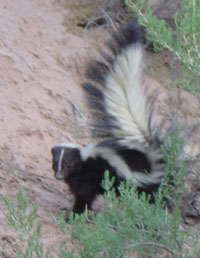 |
||||||||
| Size: Striped Skunks are the largest. They are about the size of a house cat (14 pounds). Spotted skunks are smaller (2 pounds). Hognose and Hooded Skunks reach up to five pounds. | |||||||||
|
|
Characteristics:
The bright black and white color is common to all skunks. Most animals
use color for camouflage, but skunks advertise their presence to ward
off enemies.
Most skunks have a cat-size body and two full-body stripes that begin at the base of the neck. |
||||||||
|
Striped
Skunk
|
|||||||||
|
Skunks are primarily nocturnal. They are active at night. They are usually solitary. They live alone except mothers and babies. Skunks can be active year-round. Food: Skunks are true omnivorous mammals. They eat at night and will consume insects, rodents, frogs, crayfish, bird eggs and nestlings, plus fruit, berries, and other plants. Skunks will eat nearly anything they can find or catch. Skunks do not store food, but they will raid the food of others such as weasels. |
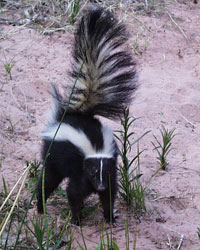 |
||||||||
|
Habitat: Skunks adapt to many habitats. They live in open, scrub, wooded, agricultural, and developed areas. Hooded and Hognose Skunks are usually found in brushy or rocky land areas. The Western Spotted Skunk can live in dry areas. They will den near water in woodlands, brush, open prairie, and among boulders and rock crevices. Skunks can dig their own burrows. They often live in the homes abandoned by other animals. In urban areas, they will also nest in houses, walls, basements, culverts, and beneath buildings. |
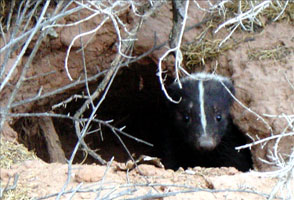 |
||||||||
|
Reproduction: Most skunks mate in late winter or early spring. Gestation time averages around sixty to seventy-five days. Baby skunks are born in May or June. The litters are usually four to seven naked, blind kits. By three weeks, their eyes are open. The young skunks stay in the burrow for about six weeks. Then, they learn to hunt from their mother during the summer. Locomotion: Skunks seldom hurry. They walk slowly. They don't usually worry about predators. Den Habits: Male skunks tend to be solitary. Several females may den together during winter. Mothers line their dens with grass and leaves for comfort. Range: Skunks are found throughout most of the 'lower 48' states. |
|||||||||
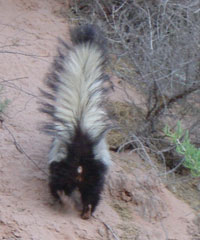 |
Self-defense: Skunks have two scent glands near the base of their tails. Each one can spray fine yellow droplets 15 feet or more. Besides the odor, it can cause temporary blindness and nausea. Even skunks dislike the smell. |
||||||||
|
Predators: Some predators can carry off a young skunk before a mother can spray. Great Horned Owls strike from above and without warning. Other predators include coyotes and dogs. The main threat to skunks are humans. Many skunks are run over by cars. At one time, Striped Skunks were hunted for their fur. More Information | Main Page | Basics | More Detail | In Depth | WebQuest | | Living Things | NatureScapes | Note:
All photographs were taken with a digital camera in Courthouse Wash,
Arches National Park, Utah. |
|||||||||
